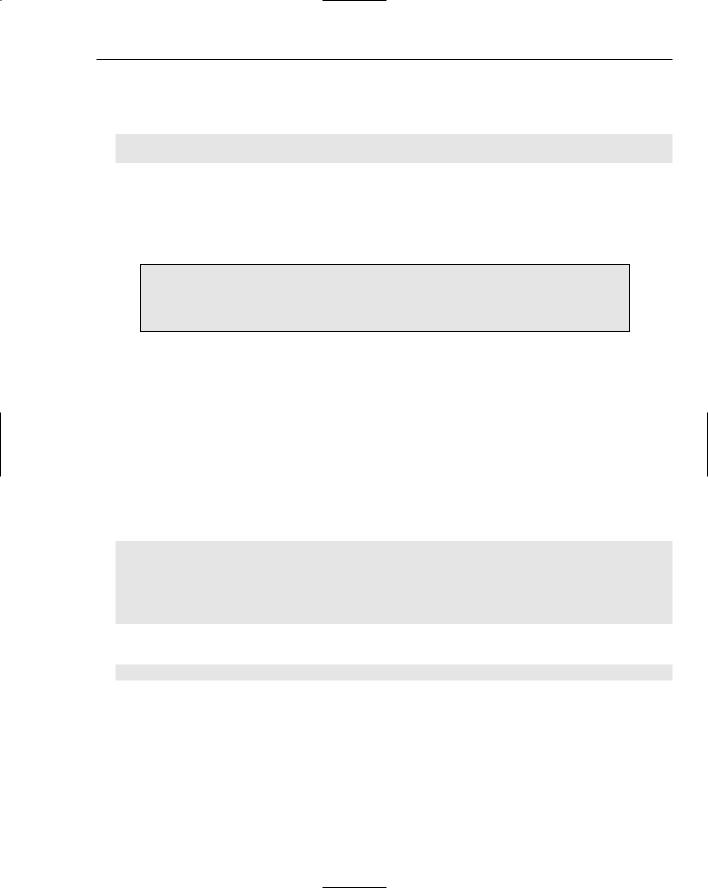
- •Contents
- •Introduction
- •Who This Book Is For
- •What This Book Covers
- •How This Book Is Structured
- •What You Need to Use This Book
- •Conventions
- •Source Code
- •Errata
- •p2p.wrox.com
- •The Basics of C++
- •The Obligatory Hello, World
- •Namespaces
- •Variables
- •Operators
- •Types
- •Conditionals
- •Loops
- •Arrays
- •Functions
- •Those Are the Basics
- •Diving Deeper into C++
- •Pointers and Dynamic Memory
- •Strings in C++
- •References
- •Exceptions
- •The Many Uses of const
- •C++ as an Object-Oriented Language
- •Declaring a Class
- •Your First Useful C++ Program
- •An Employee Records System
- •The Employee Class
- •The Database Class
- •The User Interface
- •Evaluating the Program
- •What Is Programming Design?
- •The Importance of Programming Design
- •Two Rules for C++ Design
- •Abstraction
- •Reuse
- •Designing a Chess Program
- •Requirements
- •Design Steps
- •An Object-Oriented View of the World
- •Am I Thinking Procedurally?
- •The Object-Oriented Philosophy
- •Living in a World of Objects
- •Object Relationships
- •Abstraction
- •Reusing Code
- •A Note on Terminology
- •Deciding Whether or Not to Reuse Code
- •Strategies for Reusing Code
- •Bundling Third-Party Applications
- •Open-Source Libraries
- •The C++ Standard Library
- •Designing with Patterns and Techniques
- •Design Techniques
- •Design Patterns
- •The Reuse Philosophy
- •How to Design Reusable Code
- •Use Abstraction
- •Structure Your Code for Optimal Reuse
- •Design Usable Interfaces
- •Reconciling Generality and Ease of Use
- •The Need for Process
- •Software Life-Cycle Models
- •The Stagewise and Waterfall Models
- •The Spiral Method
- •The Rational Unified Process
- •Software-Engineering Methodologies
- •Extreme Programming (XP)
- •Software Triage
- •Be Open to New Ideas
- •Bring New Ideas to the Table
- •Thinking Ahead
- •Keeping It Clear
- •Elements of Good Style
- •Documenting Your Code
- •Reasons to Write Comments
- •Commenting Styles
- •Comments in This Book
- •Decomposition
- •Decomposition through Refactoring
- •Decomposition by Design
- •Decomposition in This Book
- •Naming
- •Choosing a Good Name
- •Naming Conventions
- •Using Language Features with Style
- •Use Constants
- •Take Advantage of const Variables
- •Use References Instead of Pointers
- •Use Custom Exceptions
- •Formatting
- •The Curly Brace Alignment Debate
- •Coming to Blows over Spaces and Parentheses
- •Spaces and Tabs
- •Stylistic Challenges
- •Introducing the Spreadsheet Example
- •Writing Classes
- •Class Definitions
- •Defining Methods
- •Using Objects
- •Object Life Cycles
- •Object Creation
- •Object Destruction
- •Assigning to Objects
- •Distinguishing Copying from Assignment
- •The Spreadsheet Class
- •Freeing Memory with Destructors
- •Handling Copying and Assignment
- •Different Kinds of Data Members
- •Static Data Members
- •Const Data Members
- •Reference Data Members
- •Const Reference Data Members
- •More about Methods
- •Static Methods
- •Const Methods
- •Method Overloading
- •Default Parameters
- •Inline Methods
- •Nested Classes
- •Friends
- •Operator Overloading
- •Implementing Addition
- •Overloading Arithmetic Operators
- •Overloading Comparison Operators
- •Building Types with Operator Overloading
- •Pointers to Methods and Members
- •Building Abstract Classes
- •Using Interface and Implementation Classes
- •Building Classes with Inheritance
- •Extending Classes
- •Overriding Methods
- •Inheritance for Reuse
- •The WeatherPrediction Class
- •Adding Functionality in a Subclass
- •Replacing Functionality in a Subclass
- •Respect Your Parents
- •Parent Constructors
- •Parent Destructors
- •Referring to Parent Data
- •Casting Up and Down
- •Inheritance for Polymorphism
- •Return of the Spreadsheet
- •Designing the Polymorphic Spreadsheet Cell
- •The Spreadsheet Cell Base Class
- •The Individual Subclasses
- •Leveraging Polymorphism
- •Future Considerations
- •Multiple Inheritance
- •Inheriting from Multiple Classes
- •Naming Collisions and Ambiguous Base Classes
- •Interesting and Obscure Inheritance Issues
- •Special Cases in Overriding Methods
- •Copy Constructors and the Equals Operator
- •The Truth about Virtual
- •Runtime Type Facilities
- •Non-Public Inheritance
- •Virtual Base Classes
- •Class Templates
- •Writing a Class Template
- •How the Compiler Processes Templates
- •Distributing Template Code between Files
- •Template Parameters
- •Method Templates
- •Template Class Specialization
- •Subclassing Template Classes
- •Inheritance versus Specialization
- •Function Templates
- •Function Template Specialization
- •Function Template Overloading
- •Friend Function Templates of Class Templates
- •Advanced Templates
- •More about Template Parameters
- •Template Class Partial Specialization
- •Emulating Function Partial Specialization with Overloading
- •Template Recursion
- •References
- •Reference Variables
- •Reference Data Members
- •Reference Parameters
- •Reference Return Values
- •Deciding between References and Pointers
- •Keyword Confusion
- •The const Keyword
- •The static Keyword
- •Order of Initialization of Nonlocal Variables
- •Types and Casts
- •typedefs
- •Casts
- •Scope Resolution
- •Header Files
- •C Utilities
- •Variable-Length Argument Lists
- •Preprocessor Macros
- •How to Picture Memory
- •Allocation and Deallocation
- •Arrays
- •Working with Pointers
- •Array-Pointer Duality
- •Arrays Are Pointers!
- •Not All Pointers Are Arrays!
- •Dynamic Strings
- •C-Style Strings
- •String Literals
- •The C++ string Class
- •Pointer Arithmetic
- •Custom Memory Management
- •Garbage Collection
- •Object Pools
- •Function Pointers
- •Underallocating Strings
- •Memory Leaks
- •Double-Deleting and Invalid Pointers
- •Accessing Out-of-Bounds Memory
- •Using Streams
- •What Is a Stream, Anyway?
- •Stream Sources and Destinations
- •Output with Streams
- •Input with Streams
- •Input and Output with Objects
- •String Streams
- •File Streams
- •Jumping around with seek() and tell()
- •Linking Streams Together
- •Bidirectional I/O
- •Internationalization
- •Wide Characters
- •Non-Western Character Sets
- •Locales and Facets
- •Errors and Exceptions
- •What Are Exceptions, Anyway?
- •Why Exceptions in C++ Are a Good Thing
- •Why Exceptions in C++ Are a Bad Thing
- •Our Recommendation
- •Exception Mechanics
- •Throwing and Catching Exceptions
- •Exception Types
- •Throwing and Catching Multiple Exceptions
- •Uncaught Exceptions
- •Throw Lists
- •Exceptions and Polymorphism
- •The Standard Exception Hierarchy
- •Catching Exceptions in a Class Hierarchy
- •Writing Your Own Exception Classes
- •Stack Unwinding and Cleanup
- •Catch, Cleanup, and Rethrow
- •Use Smart Pointers
- •Common Error-Handling Issues
- •Memory Allocation Errors
- •Errors in Constructors
- •Errors in Destructors
- •Putting It All Together
- •Why Overload Operators?
- •Limitations to Operator Overloading
- •Choices in Operator Overloading
- •Summary of Overloadable Operators
- •Overloading the Arithmetic Operators
- •Overloading Unary Minus and Unary Plus
- •Overloading Increment and Decrement
- •Overloading the Subscripting Operator
- •Providing Read-Only Access with operator[]
- •Non-Integral Array Indices
- •Overloading the Function Call Operator
- •Overloading the Dereferencing Operators
- •Implementing operator*
- •Implementing operator->
- •What in the World Is operator->* ?
- •Writing Conversion Operators
- •Ambiguity Problems with Conversion Operators
- •Conversions for Boolean Expressions
- •How new and delete Really Work
- •Overloading operator new and operator delete
- •Overloading operator new and operator delete with Extra Parameters
- •Two Approaches to Efficiency
- •Two Kinds of Programs
- •Is C++ an Inefficient Language?
- •Language-Level Efficiency
- •Handle Objects Efficiently
- •Use Inline Methods and Functions
- •Design-Level Efficiency
- •Cache as Much as Possible
- •Use Object Pools
- •Use Thread Pools
- •Profiling
- •Profiling Example with gprof
- •Cross-Platform Development
- •Architecture Issues
- •Implementation Issues
- •Platform-Specific Features
- •Cross-Language Development
- •Mixing C and C++
- •Shifting Paradigms
- •Linking with C Code
- •Mixing Java and C++ with JNI
- •Mixing C++ with Perl and Shell Scripts
- •Mixing C++ with Assembly Code
- •Quality Control
- •Whose Responsibility Is Testing?
- •The Life Cycle of a Bug
- •Bug-Tracking Tools
- •Unit Testing
- •Approaches to Unit Testing
- •The Unit Testing Process
- •Unit Testing in Action
- •Higher-Level Testing
- •Integration Tests
- •System Tests
- •Regression Tests
- •Tips for Successful Testing
- •The Fundamental Law of Debugging
- •Bug Taxonomies
- •Avoiding Bugs
- •Planning for Bugs
- •Error Logging
- •Debug Traces
- •Asserts
- •Debugging Techniques
- •Reproducing Bugs
- •Debugging Reproducible Bugs
- •Debugging Nonreproducible Bugs
- •Debugging Memory Problems
- •Debugging Multithreaded Programs
- •Debugging Example: Article Citations
- •Lessons from the ArticleCitations Example
- •Requirements on Elements
- •Exceptions and Error Checking
- •Iterators
- •Sequential Containers
- •Vector
- •The vector<bool> Specialization
- •deque
- •list
- •Container Adapters
- •queue
- •priority_queue
- •stack
- •Associative Containers
- •The pair Utility Class
- •multimap
- •multiset
- •Other Containers
- •Arrays as STL Containers
- •Strings as STL Containers
- •Streams as STL Containers
- •bitset
- •The find() and find_if() Algorithms
- •The accumulate() Algorithms
- •Function Objects
- •Arithmetic Function Objects
- •Comparison Function Objects
- •Logical Function Objects
- •Function Object Adapters
- •Writing Your Own Function Objects
- •Algorithm Details
- •Utility Algorithms
- •Nonmodifying Algorithms
- •Modifying Algorithms
- •Sorting Algorithms
- •Set Algorithms
- •The Voter Registration Audit Problem Statement
- •The auditVoterRolls() Function
- •The getDuplicates() Function
- •The RemoveNames Functor
- •The NameInList Functor
- •Testing the auditVoterRolls() Function
- •Allocators
- •Iterator Adapters
- •Reverse Iterators
- •Stream Iterators
- •Insert Iterators
- •Extending the STL
- •Why Extend the STL?
- •Writing an STL Algorithm
- •Writing an STL Container
- •The Appeal of Distributed Computing
- •Distribution for Scalability
- •Distribution for Reliability
- •Distribution for Centrality
- •Distributed Content
- •Distributed versus Networked
- •Distributed Objects
- •Serialization and Marshalling
- •Remote Procedure Calls
- •CORBA
- •Interface Definition Language
- •Implementing the Class
- •Using the Objects
- •A Crash Course in XML
- •XML as a Distributed Object Technology
- •Generating and Parsing XML in C++
- •XML Validation
- •Building a Distributed Object with XML
- •SOAP (Simple Object Access Protocol)
- •. . . Write a Class
- •. . . Subclass an Existing Class
- •. . . Throw and Catch Exceptions
- •. . . Read from a File
- •. . . Write to a File
- •. . . Write a Template Class
- •There Must Be a Better Way
- •Smart Pointers with Reference Counting
- •Double Dispatch
- •Mix-In Classes
- •Object-Oriented Frameworks
- •Working with Frameworks
- •The Model-View-Controller Paradigm
- •The Singleton Pattern
- •Example: A Logging Mechanism
- •Implementation of a Singleton
- •Using a Singleton
- •Example: A Car Factory Simulation
- •Implementation of a Factory
- •Using a Factory
- •Other Uses of Factories
- •The Proxy Pattern
- •Example: Hiding Network Connectivity Issues
- •Implementation of a Proxy
- •Using a Proxy
- •The Adapter Pattern
- •Example: Adapting an XML Library
- •Implementation of an Adapter
- •Using an Adapter
- •The Decorator Pattern
- •Example: Defining Styles in Web Pages
- •Implementation of a Decorator
- •Using a Decorator
- •The Chain of Responsibility Pattern
- •Example: Event Handling
- •Implementation of a Chain of Responsibility
- •Using a Chain of Responsibility
- •Example: Event Handling
- •Implementation of an Observer
- •Using an Observer
- •Chapter 1: A Crash Course in C++
- •Chapter 3: Designing with Objects
- •Chapter 4: Designing with Libraries and Patterns
- •Chapter 5: Designing for Reuse
- •Chapter 7: Coding with Style
- •Chapters 8 and 9: Classes and Objects
- •Chapter 11: Writing Generic Code with Templates
- •Chapter 14: Demystifying C++ I/O
- •Chapter 15: Handling Errors
- •Chapter 16: Overloading C++ Operators
- •Chapter 17: Writing Efficient C++
- •Chapter 19: Becoming Adept at Testing
- •Chapter 20: Conquering Debugging
- •Chapter 24: Exploring Distributed Objects
- •Chapter 26: Applying Design Patterns
- •Beginning C++
- •General C++
- •I/O Streams
- •The C++ Standard Library
- •C++ Templates
- •Integrating C++ and Other Languages
- •Algorithms and Data Structures
- •Open-Source Software
- •Software-Engineering Methodology
- •Programming Style
- •Computer Architecture
- •Efficiency
- •Testing
- •Debugging
- •Distributed Objects
- •CORBA
- •XML and SOAP
- •Design Patterns
- •Index

Exploring Distributed Objects
If the <dialogue> document is provided as input, this program will produce the following output:
Found tag named: dialogue
Found text data:
Found tag named: sentence
Found attribute pair: (speaker=Marni)
Found text data: Let’s go get some ice cream.
Found text data:
Found tag named: sentence
Found attribute pair: (speaker=Scott)
Found text data: After I’m done writing this C++ book.
Found text data:
Note that the white space between tags is being read as a text node.
The Xerces library is exception-savvy. The previous example will abort in the face of an exception other than bad_cast, but a production-quality application would catch and handle Xerces exceptions.
XML Validation
XML is a general-purpose syntax with no predefined tags or semantics of its own. However, that doesn’t mean that any XML application can interpret any XML input. When you write an application that deals with XML, you need to specify the specific type of XML that you can interpret. XML validation allows you to define the specific format of XML that your application allows, including the element names, their organization, and their attributes.
DTD (Document Type Definition)
Document Type Definitions are the original technique for specifying the type of an XML document. The structure of a DTD initially looks like XML itself, but it’s not. Instead of a hierarchical format, DTDs are written as a series of declarations about the document type. The details of DTD creation are beyond the scope of this book. To give you an idea of what a DTD looks like, however, here is the DTD corresponding to the <dialogue> document:
<?xml version=”1.0” encoding=”UTF-8”?> <!ELEMENT dialogue (sentence+)> <!ELEMENT sentence (#PCDATA)>
<!ATTLIST sentence
speaker (Marni | Scott) #REQUIRED
>
Inside of an XML document, you can specify the DTD to which it conforms by including a DOCTYPE assertion at the top of the file:
721

Chapter 24
<?xml version=”1.0”?>
<!DOCTYPE dialogue SYSTEM “dialogue.dtd”> <dialogue>
<sentence speaker=”Marni”>Let’s go get some ice cream.</sentence> <sentence speaker=”Scott”>After I’m done writing this C++ book.</sentence>
</dialogue>
The DOCTYPE assertion requires two parameters. The first is the root element of the document and the second is the location of the DTD file. In this case, the DTD resides on the local system in a file named dialogue.dtd.
Most XML parsing libraries, including Xerces, can validate an XML file against its DTD. That way, you can guarantee that your program will only operate on data that it can interpret.
XML Schema
Validation of XML documents is a great idea, but the DTD format leaves much to be desired. On complex documents, DTDs quickly become unwieldy. They also don’t provide facilities for defining complex types, ordering, or data content. Not to mention the fact that DTDs aren’t even written in XML!
XML Schema is an attempt to provide a more functional way of defining the type of an XML document. XML Schema definitions are vastly more flexible than DTDs, but that added flexibility brings added complexity. There are several excellent books about XML Schema (see Appendix B), so we will again provide only a very simple example:
<?xml version=”1.0” encoding=”UTF-8”?>
<xs:schema xmlns:xs=”http://www.w3.org/2001/XMLSchema”> <xs:element name=”dialogue”>
<xs:complexType>
<xs:sequence>
<xs:element ref=”sentence” maxOccurs=”unbounded”/> </xs:sequence>
</xs:complexType>
</xs:element>
<xs:element name=”sentence”> <xs:complexType>
<xs:simpleContent>
<xs:extension base=”xs:string”>
<xs:attribute name=”speaker” use=”required”> <xs:simpleType>
<xs:restriction base=”xs:NMTOKEN”> <xs:enumeration value=”Marni”/> <xs:enumeration value=”Scott”/>
</xs:restriction>
</xs:simpleType>
</xs:attribute>
</xs:extension>
</xs:simpleContent>
</xs:complexType>
</xs:element>
</xs:schema>
722

Exploring Distributed Objects
Just as with a DTD, you can correlate an XML schema with an XML document. Instead of using a DOCTYPE declaration, you specify the location of the schema within an attribute of the root element:
<?xml version=”1.0”?>
<dialogue xmlns:xsi=”http://www.w3.org/2001/XMLSchema-instance”
xsi:noNamespaceSchemaLocation=”dialogue.xsd”>
<sentence speaker=”Marni”>Let’s go get some ice cream.</sentence> <sentence speaker=”Scott”>After I’m done writing this C++ book.</sentence>
</dialogue>
Note that the xmlns:xsi attribute specifies that the document is an instance of the XML Schema located at the xsi:noNamespaceSchemaLocation attribute.
Software packages such as xmlspy from Altova Software (www.xmlspy.com) can greatly ease the process of generating and interpreting XML, XML schemas, and DTDs.
Building a Distributed Object with XML
An XML distributed object is simply an object that knows how to output itself as XML and populate itself from XML. In this section, you will turn the Simple class defined earlier into a distributed object using XML serialization.
The XMLSerializable Mix-in Class
In an application that deals with many distributed objects, it is often convenient to have a common parent class for all such objects. The XMLSerializable class, defined in the following example, requires that subclasses implement methods to read themselves from XML and write themselves to XML. This is an example of a mix-in class (see Chapter 25 for further details).
class XMLSerializable
{
public:
virtual std::string toXML() = 0;
virtual void fromXML(const std::string& inXML) = 0;
};
Here is the new Simple class, modified to inherit from XMLSerializable:
class Simple : public XMLSerializable
{
public:
std::string mName; int mPriority;
std::string mData;
723

Chapter 24
virtual std::string toXML();
virtual void fromXML(const std::string& inXML);
};
Implementing XML Serialization
The actual serialization code is aided greatly by the XMLElement class implemented earlier and the use of the Xerces library:
string Simple::toXML()
{
XMLElement simpleElement; simpleElement.setElementName(“simple”);
simpleElement.setAttribute(“name”, mName);
//Convert the int into a string. ostringstream tempStream; tempStream << mPriority;
simpleElement.setAttribute(“priority”, tempStream.str());
//Add the data as a text node. simpleElement.setTextNode(mData);
//Convert the XMLElement into a string.
ostringstream resultStream; resultStream << simpleElement;
return resultStream.str();
}
void Simple::fromXML(const string& inString)
{
static const char* bufID = “simple buffer”;
// Use MemBufInputSource to read the XML content from a string. MemBufInputSource src((const XMLByte*)inString.c_str(),
inString.length(), bufID); XercesDOMParser* parser = new XercesDOMParser(); parser->parse(src);
DOMNode* node = parser->getDocument();
DOMDocument* document = dynamic_cast<DOMDocument*>(node); if (document == NULL) {
delete parser; return;
}
// Document should be the <simple> element. try {
const DOMElement& elementNode =
dynamic_cast<const DOMElement&>(*document->getDocumentElement());
724

Exploring Distributed Objects
// Get the name attribute.
XMLCh* nameKey = XMLString::transcode(“name”);
char* name = XMLString::transcode(elementNode.getAttribute(nameKey)); XMLString::release(&nameKey);
mName = name; XMLString::release(&name);
// Get the priority attribute.
XMLCh* priorityKey = XMLString::transcode(“priority”); char* priorityStr =
XMLString::transcode(elementNode.getAttribute(priorityKey));
XMLString::release(&priorityKey); // Parse the priority number.
istringstream tmpStream(priorityStr); tmpStream >> mPriority;
XMLString::release(&priorityStr);
// Get the data as a text node.
const XMLCh* textData = elementNode.getTextContent(); char* data = XMLString::transcode(textData);
mData = data; XMLString::release(&data);
} catch (bad_cast) {
cerr << “cast exception while parsing Simple object from XML” << endl;
}catch (...) {
cerr << “an unknown error occurred while parsing a Simple object from XML”
<< endl;
}
delete parser;
}
Following is a main() that tests the serialization functionality by creating a Simple object, writing it to XML, then reading that same XML output into a new Simple object. When finished, both objects should be equivalent.
int main(ing argc, char** argv)
{
XMLPlatformUtils::Initialize();
Simple test; test.mName = “myname”; test.mPriority = 7; test.mData = “my data”;
string xmlData = test.toXML();
Simple test2; test2.fromXML(xmlData);
725
